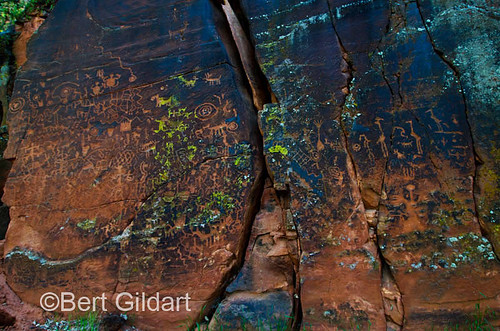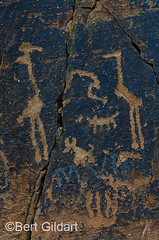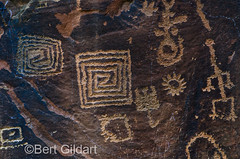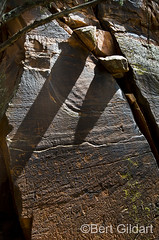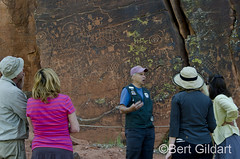Does the V-Bar-V Heritage Site Preserve a Solar Calendar?
©Bert Gildart: Among the red cliffs of Navajo sandstone just south of Sedona and north of Cottonwood, AZ, there is a rock panel that is perfectly aligned in a north-south orientation. That orientation figures into creation of some of North America’s most incredible Native American petroglyphs.
Standing before the fence intended to protect rare rock art from careless hands, one sees images of the sun, elk, deer, cranes and of many indescribable squiggly lines that until recently had meaning only to their ancient makers. Amazingly, these lines influenced a culture, and Janie and I had arrived early to see them.
But now it is afternoon and because I’ve come to realize the squiggly lines were so important and reacted with the sun so significantly, I’ve remained from the initial tour Janie and I joined to see the unfolding of a phenomena. At almost 1:15 exactly, the sun slices between two boulders that have lodged high on the cliff overhead. There are two dark lines and as they lengthen they strike a path over one of the 1,000-plus petroglyphs on the wall, specifically one of the several etched out suns referred to as the “Sun Father.” As well, the ray covers one of the squiggly lines, which our guide calls “steps.”
L to R: Details of images from the huge panel, noting suns in left image as well as pared turtles; paired cranes in middle and paired designs on right.
According to our guide, the actual sun will progress from one of the three suns created as petroglyphs. As the month progresses it will move to eventually touch the other two, simultaneously moving along the steps represented as interconnecting letter “w,” our squiggly lines. This movement requires 180 days, and it was once important to observe as it represents the vernal equinox and the beginning of planting season. Finally, about three months later, it represents the end of the planting season. After that the various crops would no longer prosper. In other words, it preserves what some believe was a solar calendar.
The conclusion, of course, is inescapable: The Southern Sinagua Indians who once occupied this site were a sophisticated group. They understood the movements of the sun and the movements of the earth. Fortunately, their way of life has all been preserved at the V-Bar-V Heritage site in a Forest Service preserved site located between Sedona and Cottonwood, Arizona.
Huge boulders and the chance alignment of the sun and wall combine with the drawings on the panel, which were not “chance” creations . All this according to interpreters provided a calender that informed on appropriate time for planting. Last image shows close up of sun (near edge of image toward bottom left) and again, interpreters explain the manner in which this lingers over the months to signify the end of the planting season. Look for the “squiggly” lines just above the turtles.
Most such sites are locked up tight (such as a solar dagger in Chaco), but this one is available for public tours and no one in the area should miss the opportunity. The two end photos were taken about 1:15 and the streaks of light remained for about 30 minutes, lengthening and then finally fading until the wall was completely blocked up, once again, in shadows. Low light works well and is the lighting I chose for all above images.
——————
AIRSTREAM TRAVELS THREE YEARS AGO:
*The Natchez Trace and Two Centuries of Travel
ADS FROM AMAZON AND GOOGLE AUGMENT OUR TRAVELS:
